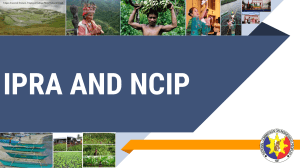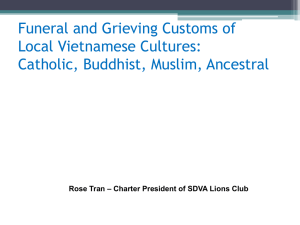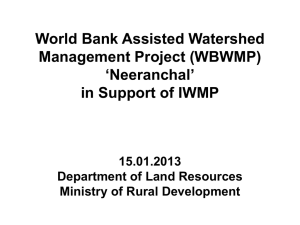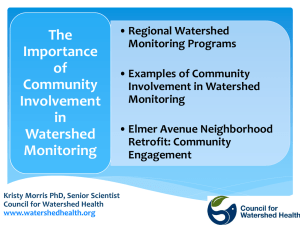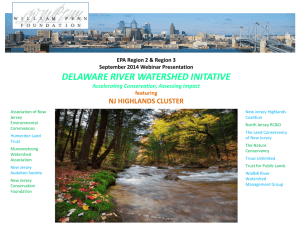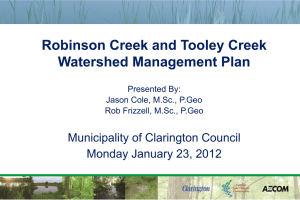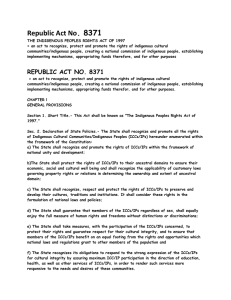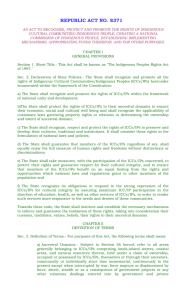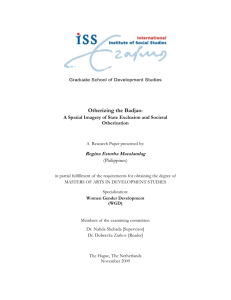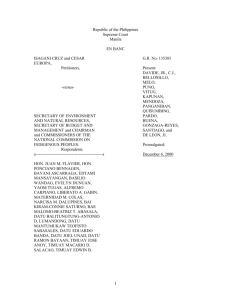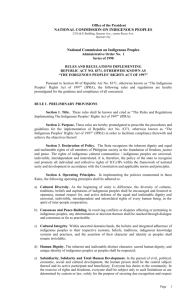Guidelines for Preparing Slides
advertisement
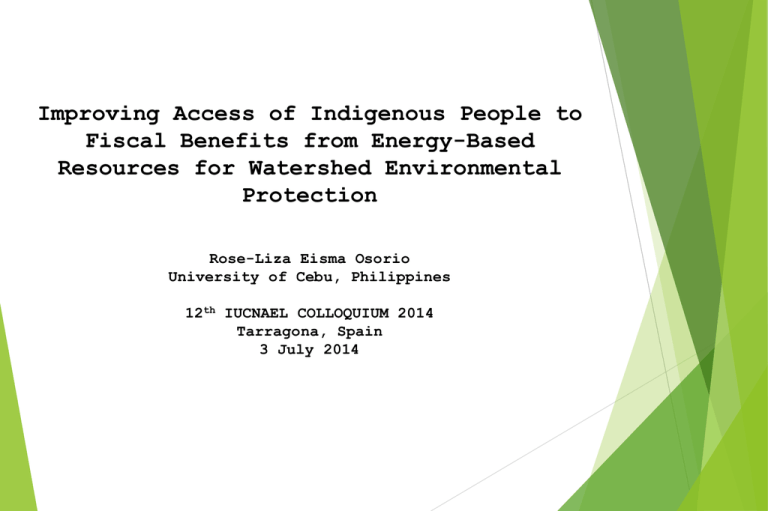
Improving Access of Indigenous People to Fiscal Benefits from Energy-Based Resources for Watershed Environmental Protection Rose-Liza Eisma Osorio University of Cebu, Philippines 12th IUCNAEL COLLOQUIUM 2014 Tarragona, Spain 3 July 2014 Critical Watersheds & Ancestral Domains Of the total Philippine land area, about 70% is considered as major watersheds within 419 river basins all over the Philippine archipelago (DENR-ERDB, 2011). Most healthy forests are within ancestral domains traditionally managed by indigenous communities The BUHITA – Ancestral Domain The BUHITA ancestral domain has a total land area of 36,547 hectares. In 2011, the BUHITA ancestral domain has a primary forest cover of 12,513 hectares or 34% of the ancestral domain and the secondary forest cover of 7,677 hectares or 21% of the land area. With the claimed forest cover, tropical flora and fauna is abundant. The BUHITA – Ancestral Domain Tagoloan River The Bukidnon Higaonon Tribal Association, Inc. (BUHITA), one of the oldest Higaonon groups, unified to secure the Certificate of Ancestral Domain Claim (CADC, 4 June 1998 by DENR) and Certificate of Ancestral Domain Title (CADT, 17 July 2009 by NCIP). The BUHITA cradles tributaries and systems of three major watersheds (and rivers), namely: [1] Tagoloan, [2] Pulangi and [3] Sawaga. Pulangui River Sawaga River Source: TROPICS, MIPPEG Pulangui Complex Pulangi I ?-Batang 150 MW Pulangi II Pulangi III Pulangi IV 255 MW Pulangi V 300 MW Source: Dr. Randell Espina Objectives To present and understand potential sources of funds, specifically from environmental charges intended for watershed management, that could potentially help support and alleviate the lives of BUHITA and other Communities. 2. To explore sustainable mechanisms to help support indigenous communities protecting headwaters of the watershed. 1. RA 9136- Electric Power Industry Reform Act(EPIRA)of 2001 Section 66. Benefits to host communities (ER 1-94) generation companies and energy resource developers are mandated to provide direct benefits to the host communities of the energy generating facilities and/or energy resource developers, which include privately-owned corporations or entities utilizing the national wealth of the locality. One-centavo per kilowatt-hour (P0.01/kWh) of the Electricity Sales which shall apply to Generation Facilities and/or energy resource development projects located in all barangays, municipalities, cities, provinces and regions. RA 9136- Electric Power Industry Reform Act(EPIRA)of 2001 Section 3 (b) (iii). Beneficiaries with respect to energy resources: “The host LGU or region is that where the hydro reservoir is located as delineated by detailed topographic, geological and geo-technical investigations, reservoir and dam height optimization studies, and as delineated by detailed ground surveys.” RA 9136 IRR (Rule 29, Part A) clearly identifies that the main beneficiaries are those communities where the facilities (Reservoir, Penstock and Power Plant) are physically located. RA 9136- Electric Power Industry Reform Act(EPIRA)of 2001 Section 34(d) Environmental Charge at P 0.0025/kwh which shall accrue to an environmental fund to be used solely for watershed rehabilitation and management. Said fund shall be managed by NPC under existing arrangements. RA 9136 IRR (Rule 18, Sec 2(v)) Environmental Charge of P 0.0025 per kWh sales to be used for rehabilitation and management of watershed areas. The universal charge shall be non-bypassable charge which shall be passed on and collected from all end-users on a monthly basis by the distribution utilities. Legal Framework Year Office Policy Name Salient Rules 1971 NAPOCOR RA 6395 An Act Revising the Charter Section 3. (f) Take water from any public stream, of the National Power river, etc. for the (g) development of hydro project… Corporation (NAPOCOR) (n) control watersheds surrounding the reservoir and (o) prevent environmental pollution and conserve natural resources 1976 NWRB PD 1067 The Water Code of the Philippines Article 3(d). Water resources protection and control 1986 OEA EO 193 The Act Providing for the Reorganization of the Office of Energy Affairs Section 3. Ensure continuous supply of energy and explore and develop indigenous energy resources 1987 NAPOCOR EO 224 Complete Jurisdiction, Control and Regulation Over Watershed Areas and Reservations Surrounding its Power Generating Plants Section 1. Watersheds: (1) Upper Agno, (2) Angat, (3) Caliraya-Lumot, (4) Makiling-Banahaw, (5) BuhiBarat, (6) Tiwi. Section 2. Watershed protection and management 1992 DOE RA 7638 DOE Act of 1992 Section 5(i). Devise ways & means to give benefits to the people Source: Dr. Randell Espina Legal Framework Year Office Policy Name Salient Rules 1994 DOE ER 1-94 Benefits to Host Communities Host communities benefits 1997 DENR RA 8371 Indigenous Peoples Rights Act of 1997 (IPRA) Section 1. Promote, recognize, respect and protect the IPs. 2001 DOE RA 9136 Electric Power Industry Reform Act (EPIRA) Section 34(d). Environmental Charge at P 0.0025/kwh for watershed rehabilitation and management. Section 66. Benefits to host communities (ER 1-94) 2004 DENR RA 9275 Philippines Clean Water Act Section 9. National water quality management fund 2008 DOE RA 9513 Renewable Energy Act of 2008 Section 31. Incentives for RE host communities (80% (RE) of share from royalty to be used for subsidy) Source: Dr. Randell Espina NAPOCOR Managed Watersheds ERC Case No. Date Petitioned 2011 2012-040 RC 07 March 2012 2013-038 RC 01 April 2013 Particulars Missionary Electrification Environmental Charge Stranded Debts Stranded Contract Costs (NPC&Dus) Equalization of Taxes and Royalties Total Amount (P) Balance (P) Date (as of) 100,550,000.00 703,510,000.00 30 September 2011 287,436,888.65 838,000,000.00 July 2012 300,666,802.17 Collections Interests Disbursements Balance 18.238 0.998 ---Start of Collection April 2013 ---- 0.043 0.058 ------- 18.263 0.339 ------- 0.02 0.72 ------- ---- ---- ---- 19.236 0.101 18.602 0.735 Total Collection Acrrued from Universal Charge as of 31 October 2011 (In Billion Php). Enano, et al, 2013 Current Challenges Indigenous peoples communities, directly hosting such resource within their ancestral lands and/or domains but those residing in the watershed headwaters (upstream) far from the facility, generally do not receive funds for watershed management.* Existing guidelines allow discretion on the part of NPC to enable access by indigenous peoples communities (Section 2, ERC Rules and Regulations regarding the utilization and disbursement of UC-EC). No royalties given to the direct IP communities dwelling alongside the river in the upstream area.* *Based on Enano, et al 2013 (ADDU-TROPICS) study ER 1-94 – Benefits from Pulangui HEPP-4 Rights of Indigenous Peoples 1987 Constitution. Article II, Section 22. The State recognizes and promotes the rights of indigenous cultural communities within the framework of national unity and development RA 8371 (IPRA) Right to Benefits. The ICCs/IPs have the right to benefit from the utilization, extraction, use and development of lands and natural resources within their ancestral lands/domains and to be compensated for any social and/or environmental costs of such activities. Rule III, Part II, Section 2(a) of RA 8371 IRR. Right to Benefits. The ICCs/IPs have the right to benefit from the utilization, extraction, use and development of lands and natural resources within their ancestral lands/domains and to be compensated for any social and/or environmental costs of such activities. Concept of Ancestral Domains Ancestral Domains refer to all areas generally belonging to ICCs/IPs comprising lands, inland waters, coastal areas, and natural resources therein, held under a claim of ownership, occupied or possessed by ICCs/IPs, themselves or through their ancestors, communally or individually since time immemorial, continuously to the present except when interrupted by war, force majeure or displacement by force, deceit, stealth or as a consequence of government projects or any other voluntary dealings entered into by government and private individuals, corporations, and which are necessary to ensure their economic, social and cultural welfare. Includes ancestral land, forests, pasture, residential, agricultural, and other lands individually owned whether alienable and disposable or otherwise, hunting grounds, burial grounds, worship areas, bodies of water, mineral and other natural resources, and lands which may no longer be exclusively occupied by ICCs/IPs but from which their traditionally had access to for their subsistence and traditional activities, particularly the home ranges of nomadic and shifting cultivator ICCs/IPs Rights to Ancestral Domains Include the right to develop, control and use lands and territories traditionally occupied, owned, or used; to manage and conserve natural resources within the territories and uphold the responsibilities for future generations; to benefit and share the profits from allocation and utilization of the natural resources found therein; the right to negotiate the terms and conditions for the exploration of natural resources in the areas for the purpose of ensuring ecological, environmental protection and the conservation measures, pursuant to national and customary laws; the right to an informed and intelligent participation in the formulation and implementation of any project, government or private, that will affect or impact upon the ancestral domains and to receive just and fair compensation for any damages which they sustain as a result of the project; and the right to effective measures by the government to prevent any interfere with, alienation and encroachment upon these rights. Policies on IP Rights and their Ancestral Domains The right of ownership and possession by the indigenous communities of their ancestral domains is distinct and do not constitute part of the public domain (J. Puno, Separate Opinion, Cruz v. Secretary of Environment and Natural Resources, et al, G.R. No. 135385, December 6, 2000.) Enabling law for IP communities considers ancestral domains to include “such concepts of territories which cover not only the physical environment but the total environment including the spiritual and cultural bonds to the areas which the ICCs/IPs possess, occupy and use and to which they have claims of ownership” Policy Proposals Integrating Rights of Indigenous Communities into Energy Regulations and Watershed Perspective into the Current Policies • Definition of host communities should not be LGU-centric, with preferential benefits given only to LGUs (barangay to regional) close to the facility. • Main beneficiaries to include indigenous peoples communities directly hosting the facilities within their ancestral lands and/or domains Policy Proposals Guidelines for the utilization of government subsidy shall specifically state the priority distribution of funds for reforestation and watershed management • Need to integrate a watershed perspective in the current policies • Reliability of energy derived from the hydro-electric facility, such as Pulangi HEPP4, greatly depends on the healthy condition of the watershed and participation of all stakeholders. Watersheds and IPs Findings showed that ‘traditional resource management practices of ICCs are more effective in protecting the forest than strict protection of government alone’ (World Bank Independent Review, Nelson & Chomitez 2009, Protected Area Effectiveness in Reducing Tropical Deforestation) Source: MIPPEG Watersheds and IPs Low Levels of forest destruction in areas that had been declared as strict protection parks by the government compared to traditionally protected areas by ICCs’ (Manuel Guarigata Sr., Center for International Forestry Research 2011) Policy Proposals Expanding the operational definition of ‘host communities’ Host communities should be construed to mean not only the LGUs but also upstream communities protecting the headwaters and downstream communities until the final discharge point. Preferential treatment shall be given to IP communities protecting the headwaters as target host communities. Changing the operational meaning of ‘watersheds’ ‘The topographic and hydrological boundaries that starts from the highest ridge, where surface runoff starts to flow, to the point of the last scheme of water utilization, which is the hydro or geothermal power plant’ Final Word: Energy as possible source of improving sustainability of watersheds Enhance policy guidelines that will enable more inclusionary administrative guidelines that address the due benefits of IPs residing within energy-generating watershed locales and the need to improve watershed protection and management
